Development of Scalable On-Line Anomaly Detection System for Autonomous and Adaptive Manufacturing Processes
Abstract
:Featured Application
Abstract
1. Introduction
2. Anomaly Detection from Event Log
2.1. Conformance Checking in a Business Process Area
2.2. Anomaly Detection Beyond the Business Process
3. Scalable On-line Anomaly Detection System (SOADS)
3.1. Architecture of SOADS
3.1.1. Event Log Preprocessor
3.1.2. Sequence Extractor
3.1.3. Relational Dependency Updater
3.1.4. Frequent Subsequence Miner
3.1.5. Anomaly Evaluator
3.2. Implementation
3.2.1. Event Log Preprocessor
3.2.2. Sequence Extractor
3.2.3. Relational Dependency Updater
3.2.4. Frequent Subsequence Miner
| Algorithm 1: prefixSpan for SOADS |
| A = { a|a∈A is a set of read points } t = { a1,a2,a3…an|a1..an∈A, a1..an is a sequence of read points } S = { s|s∈S is a set of sequences } R = { (ai,ao)|ai,ao∈A, ai is a input activity, ao is a output read points} RF = { (r,f)|r∈R, f is a frequency of r in T} 1: Function prefixSpanForSOADS(RF, S, minsup) 2: foreach RF do 3: if f ≥ minsup then 4: P ← P ∪ r//r∈ RF 5: return prefixSpan(P, minsup, ProjectedDB(R, S)) 6: 7: SubFunction prefixSpan(prefix, minsup, DB) 8: <b> ← extractPrefix(minsup, DB) 10: for each b do 11: prefix’ ← prefix + b 12: P ← P ∪ prefix’ 13: P ← P ∪ prefixSpan(prefix’, minsup, ProjectedDB(prefix’, DB)) 14: return P |
3.2.5. Anomaly Evaluator
4. Performance Test of SOADS
4.1. Overall Processes of Battery Manufacturing
4.2. Simulation Modeling
4.3. Test Environment
4.4. Performance Test of Frequent Subsequence Miner
4.5. Performance Test of Anomaly Evaluator
5. Conclusions and Future Work
Author Contributions
Funding
Conflicts of Interest
References
- Rubmann, M.; Lorenz, M.; Gerber, P.; Waldner, M.; Justus, J.; Engel, P.; Harnisch, M. Industry 4.0: The Future of Productivity and Growth in Manufacturing Industries. BCG Online Article. April 2015. Available online: https://www.bcg.com/enkr/publications/2015/engineered_products_project_business_industry_4_future_productivity_growth_manufacturing_industries.aspx (accessed on 2 May 2018).
- Kang, H.S.; Lee, J.Y.; Choi, S.; Kim, H.; Park, J.H.; Son, J.Y.; Noh, S.D. Smart manufacturing: Past research, present findings, and future directions. Int. J. Precis. Eng. Manuf. Green Technol. 2016, 3, 111–128. [Google Scholar] [CrossRef]
- Radziwon, A.; Bilberg, A.; Bogers, M.; Madsen, E.S. The smart factory: Exploring adaptive and flexible manufacturing solutions. Procedia Eng. 2014, 69, 1184–1190. [Google Scholar] [CrossRef]
- Lee, J.; Bagheri, B.; Kao, H.A. A cyber-physical systems architecture for industry 4.0-based manufacturing systems. Manuf. Lett. 2015, 3, 18–23. [Google Scholar] [CrossRef]
- Wang, S.; Wan, J.; Li, D.; Zhang, C. Implementing smart factory of industrie 4.0: An outlook. Int. J. Distrib. Sens. Netw. 2016, 2016, 3159805. [Google Scholar] [CrossRef]
- Weiss, R. Adidas Brings the Fast Shoe Revolution One Step Closer. 5 October 2017. Available online: https://www.bloomberg.com/news/articles/2017-10-05/adidas-brings-the-fast-shoe-revolution-one-step-closer (accessed on 25 September 2019).
- Fast, Flexible, Modular Production Technology Provides Platform for Future European Growth. Available online: https://cordis.europa.eu/docs/results/228867/final1-f3-factory-keymessages-and-casestudy-summaries.pdf (accessed on 25 September 2019).
- Rozinat, A.; van der Aalst, W.M.P. Conformance checking of processes based on monitoring real behavior. Inf. Syst. 2008, 33, 64–95. [Google Scholar] [CrossRef]
- Bezerra, F.; Wainer, J. Algorithms for anomaly detection of traces in logs of process aware information systems. Inf. Syst. 2013, 38, 33–44. [Google Scholar] [CrossRef]
- Adriansyah, A. Aligning Observed and Modeled Behavior. Ph.D. Thesis, Eindhoven University of Technology, Department of Mathematics and Computer Science, Eindhoven, Paises Baixos, 1 January 2014. [Google Scholar]
- Myers, D.; Suriadi, S.; Radke, K.; Foo, E. Anomaly detection for industrial control systems using process mining. Comput. Secur. 2018, 78, 103–125. [Google Scholar] [CrossRef]
- van der Aalst, W.M.P. Process Mining—Data Science in Action, 2nd ed.; Springer: Berlin/Heidelberg, Germany, 2016. [Google Scholar] [CrossRef]
- Burattin, A.; Cimitile, M.; Maggi, F.M.; Sperduti, A. Online discovery of declarative process models from event streams. IEEE Trans. Serv. Comput. 2015, 8, 833–846. [Google Scholar] [CrossRef]
- Hassani, M.; Siccha, S.; Richter, F.; Seidl, T. Efficient process discovery from event streams using sequential pattern mining. In Proceedings of the 2015 IEEE Symposium Series on Computational Intelligence, Cape Town, South Africa, 7–10 December 2015; pp. 1366–1373. [Google Scholar]
- van Zelst, S.J.; van Dongen, B.F.; van der Aalst, W.M. Event stream-based process discovery using abstract representations. Knowl. Inf. Syst. 2018, 54, 407–435. [Google Scholar] [CrossRef]
- van Zelst, S.J.; Bolt, A.; Hassani, M.; van Dongen, B.F.; van der Aalst, W.M. Online conformance checking: Relating event streams to process models using prefix-alignments. Int. J. Data Sci. Anal. 2017, 27, 1–16. [Google Scholar] [CrossRef]
- Burattin, A.; van Zelst, S.J.; Armas-Cervantes, A.; van Dongen, B.F.; Carmona, J. Online conformance checking using behavioural patterns. In Proceedings of the International Conference on Business Process Management, Sydney, Australia, 9–14 September 2018; Springer: Cham, Switzerland, 2018; pp. 250–267. [Google Scholar]
- Fuzzy mining: Adaptive process simplification based on multi-perspective metrics BPM’07. In Proceedings of the Business Process Management, Brisbane, Australia, 24–28 September 2007; pp. 328–343.
- Varun, C.; Banerjee, A.; Kumar, V. Anomaly detection: A survey. ACM Comput. Surv. 2009, 41, 15. [Google Scholar]
- Denning, D.E. An intrusion-detection model. IEEE Trans. Softw. Eng. 1987, 2, 222–232. [Google Scholar] [CrossRef]
- De Stefano, C.; Sansone, C.; Vento, M. To reject or not to reject: That is the question—An answer in case of neural classifiers. IEEE Trans. Syst. Man Cybern. Syst. C 2000, 30, 84–94. [Google Scholar] [CrossRef]
- Schölkopf, B.; Platt, J.C.; Shawe-Taylor, J.; Smola, A.J.; Williamson, R.C. Estimating the support of a high-dimensional distribution. Neural Comput. 2001, 13, 1443–1471. [Google Scholar] [CrossRef]
- Hawkins, S.; He, H.; Williams, G.; Baxter, R. Outlier detection using replicator neural networks. In Proceedings of the International Conference on Data Warehousing and Knowledge Discovery, Aix-en-Provence, France, 4–6 September 2002; Springer: Berlin/Heidelberg, Germany, 2002; pp. 170–180. [Google Scholar]
- Van Der Aalst, W. Process Mining: Discovery, Conformance and Enhancement of Business Processes; Springer: Berlin/Heidelberg, Germany, 2011; Volume 2. [Google Scholar]
- Van der Aalst, W.; Adriansyah, A.; van Dongen, B. Replaying history on process models for conformance checking and performance analysis. Wiley Interdiscip. Rev. Data Min. Knowl. Discov. 2012, 2, 182–192. [Google Scholar] [CrossRef]
- Aleskerov, E.; Freisleben, B.; Rao, B. Cardwatch: A neural network based database mining system for credit card fraud detection. In Proceedings of the IEEE/IAFE 1997 Computational Intelligence for Financial Engineering (CIFEr), New York, NY, USA, 24–25 March 1997. [Google Scholar]
- Fujimaki, R.; Yairi, T.; Machida, K. An approach to spacecraft anomaly detection problem using kernel feature space. In Proceedings of the Eleventh ACM SIGKDD International Conference on Knowledge Discovery in Data Mining, Chicago, IL, USA, 21–24 August 2005. [Google Scholar]
- van der Aalst, W.M.P. Process Mining: Overview and Opportunities. ACM Trans. Manag. Inf. Syst. 2012, 3, 1–17. [Google Scholar] [CrossRef]
- Carmona, J.; van Dongen, B.F.; Solti, A.; Weidlich, M. Part II. A Deep Dive into Conformance Checking. In Conformance Checking—Relating Processes and Models; Springer: Berlin/Heidelberg, Germany, 2018; pp. 95–210. [Google Scholar]
- Carmona, J.; van Dongen, B.F.; Solti, A.; Weidlich, M. Part III. Conformance Checking Applications. In Conformance Checking—Relating Processes and Models; Springer: Berlin/Heidelberg, Germany, 2018; pp. 211–263. [Google Scholar]
- Van den Broucke, S.K.L.M.; Munoz-Gama, J.; Carmona, J.; Baesens, B.; Vanthienen, J. Event-based real-time decomposed conformance analysis. In OTM Confederated International Conferences, On the Move to Meaningful Internet Systems 2014; Springer: Berlin/Heidelberg, Germany, 2014; Volume 8841, pp. 345–363. [Google Scholar]
- van Zelst, S.J.; Bolt, A.; van Dongen, B.F. Tuning alignment computation: An experimental evaluation. In Proceedings of the International Workshop on Algorithms & Theories for the Analysis of Event Data (ATAED), Zaragoza, Spain, 26–27 June 2017; pp. 6–20. [Google Scholar]
- Teng, H.S.; Chen, K.; Lu, S.C. Adaptive real-time anomaly detection using inductively generated sequential patterns. In Proceedings of the IEEE Computer Society Symposium on Security and Privacy, Oakland, CA, USA, 6–8 May 1990. [Google Scholar]
- Leemans, S.J.J.; Fahland, D.; Van der Aalst, W.M.P. Scalable process discovery and conformance checking. Soft. Syst. Mod. 2018, 17, 599–631. [Google Scholar] [CrossRef]
- Reißner, D.; Conforti, R.; Dumas, M.; La Rosa, M.; Armas-Cervantes, A. Scalable conformance checking of business processes. In Proceedings of the OTM Confederated International Conferences On the Move to Meaningful Internet Systems, Rhodes, Greece, 23–27 October 2017; pp. 607–627. [Google Scholar]
- van der Aalst, W.; Damiani, E. Processes meet big data: Connecting data science with process science. IEEE Trans. Serv. Comput. 2015, 8, 810–819. [Google Scholar] [CrossRef]
- Alizadeh, M.; Lu, X.; Fahland, D.; Zannone, N.; van der Aalst, W.M.P. Linking data and process perspectives for conformance analysis. Comput. Secur. 2018, 73, 172–193. [Google Scholar] [CrossRef]
- Borrego, D.; Barba, I. Conformance checking and diagnosis for declarative business process models in data-aware scenarios. Expert Syst. Appl. 2014, 41, 5340–5352. [Google Scholar] [CrossRef]
- Burattin, A.; Maggi, F.M.; Sperduti, A. Conformance checking based on multi-perspective declarative process models. Expert Syst. Appl. 2016, 65, 194–211. [Google Scholar] [CrossRef] [Green Version]
- De Leoni, M.; Van Der Aalst, W.M.P.; Van Dongen, B.F. Data-and resource-aware conformance checking of business processes. In Proceedings of the International Conference on Business Information Systems, Vilnius, Lithuania, 21–23 May 2012; Springer: Berlin/Heidelberg, 2012; pp. 48–59. [Google Scholar]
- Mannhardt, F.; De Leoni, M.; Reijers, H.A.; Van Der Aalst, W.M.P. Balanced multi-perspective checking of process conformance. Computing 2016, 98, 407–437. [Google Scholar] [CrossRef]
- Škulj, G.; Butala, P. Anomaly detection in shop floor material flow: A network theory approach. CIRP Ann. 2013, 62, 487–490. [Google Scholar]
- Ladiges, J.; Fülber, A.; Arroyo, E.; Fay, A.; Haubeck, C.; Lamersdorf, W. Learning material flow models for manufacturing plants from data traces. In Proceedings of the IEEE 13th International Conference on Industrial Informatics (INDIN), Cambridge, UK, 22–24 July 2015; pp. 294–301. [Google Scholar]
- Reynolds, T.G.; Hansman, R.J. Proceedings of the IEEE 21st Digital Avionics Systems Conference, Irvine, CA, USA, 27–31 October 2002; p. 2.
- Fu, Z.; Hu, W.; Tan, T. Similarity based vehicle trajectory clustering and anomaly detection. In Proceedings of the IEEE International Conference on Image Processing, Genova, Italy, 14 September 2005; p. 2. [Google Scholar]
- Zhou, Y.; Yan, S.; Huang, T.S. Detecting anomaly in videos from trajectory similarity analysis. In Proceedings of the IEEE International Conference on Multimedia and Expo, Beijing, China, 2–5 July 2007. [Google Scholar]
- Zhang, D.; Li, N.; Zhou, Z.H.; Chen, C.; Sun, L.; Li, S. iBAT: Detecting anomalous taxi trajectories from GPS traces. In Proceedings of the 13th International Conference on Ubiquitous Computing ACM, Beijing, China, 17–21 September 2011; pp. 99–108. [Google Scholar]
- Camossi, E.; Dimitrova, T.; Tsois, A. Detecting anomalous maritime container itineraries for anti-fraud and supply chain security. In Proceedings of the 2012 European Intelligence and Security Informatics Conference, Odense, Denmark, 22–24 August 2012; pp. 76–83. [Google Scholar]
- Kwon, D.; Kim, H.; Kim, J.; Suh, S.C.; Kim, I.; Kim, K.J. A survey of deep learning-based network anomaly detection. Cluster Comput. 2017, 22, 1–13. [Google Scholar] [CrossRef]
- Cattell, R. Scalable SQL and NoSQL data stores. ACM SIGMOD Rec. 2011, 39, 12–27. [Google Scholar] [CrossRef] [Green Version]
- Agrawal, R.; Srikant, R. Mining sequential patterns. In Proceedings of the 11th Conference on Data Engineering (ICDE), Taipei, Taiwan, 6–10 March 1995; pp. 3–14. [Google Scholar]
- Hirate, Y.; Yamana, H. Generalized Sequential Pattern Mining with Item Intervals. J. Comput. 2006, 1, 51–60. [Google Scholar] [CrossRef]
- Pei, J.; Han, J.; Mortazavi-Asl, B.; Pinto, H.; Chen, Q.; Dayal, U.; Hsu, M.C. Prefixspan: Mining sequential patterns efficiently by prefix-projected pattern growth. In Proceedings of the 17th International Conference on Data Engineering, Heidelberg, Germany, 2–6 April 2001; pp. 215–224. [Google Scholar]
- Mount, D.W. Bioinformatics: Sequence and Genome Analysis, 2nd ed.; Cold Spring Harbor Laboratory Press: New York, NY, USA, 2004; Volume 692. [Google Scholar]
- Smith, T.F.; Waterman, M.S. Identification of common molecular subsequences. J. Mol. Biol. 1981, 147, 195–197. [Google Scholar] [CrossRef]
- Kang, Y.S.; Park, I.H.; Youm, S. Performance prediction of a MongoDB-based traceability system in smart factory supply chains. Sensors 2016, 16, 2126. [Google Scholar] [CrossRef]
- Zhao, G.; Ling, C.; Sun, D. SparkSW: Scalable distributed computing system for large-scale biological sequence alignment. In Proceedings of the 15th IEEE/ACM International Symposium on Cluster, Cloud and Grid Computing, Shenzen, China, 4–7 May 2015; pp. 845–852. [Google Scholar]
- Xu, B.; Li, C.; Zhuang, H.; Wang, J.; Wang, Q.; Zhou, X. Efficient distributed Smith-Waterman algorithm based on Apache Spark. In Proceedings of the 2017 IEEE 10th International Conference on Cloud Computing (CLOUD), Honolulu, HI, USA, 25–30 June 2017; pp. 608–615. [Google Scholar]
- Al-Ars, Z.; Mushtaq, H. Scalability Potential of BWA DNA Mapping Algorithm on Apache Spark. In Proceedings of the 2nd Annual International Symposium on Information Management and Big Data—SIMBig, Cusco, Peru, 2–4 September 2015; pp. 85–88. [Google Scholar]
- Dardari, D.; Pasolini, G.; Zabini, F. An efficient method for physical fields mapping through crowdsensing. Pervasive Mob. Comput. 2018, 48, 69–83. [Google Scholar] [CrossRef]
- Ma, H.; Zhao, D.; Yuan, P. Opportunities in mobile crowd sensing. IEEE Commun. Mag. 2014, 52, 29–35. [Google Scholar] [CrossRef]
- Lee, C.K.M.; Lv, Y.; Ng, K.K.H.; Ho, W.; Choy, K.L. Design and application of Internet of things-based warehouse management system for smart logistics. Int. J. Prod. Res. 2018, 56, 2753–2768. [Google Scholar] [CrossRef]
- Lom, M.; Pribyl, O.; Svitek, M. Industry 4.0 as a part of smart cities. In Proceedings of the 2016 Smart Cities Symposium Prague (SCSP), Prague, Czech Republic, 26–27 May 2016. [Google Scholar]
- Petritoli, E.; Leccese, F.; Botticelli, M.; Pizzuti, S.; Pieroni, F. A RAMS analysis for a precision scale-up configuration of “Smart Street” pilot site: An Industry 4.0 Case Study. ACTA IMEKO 2019, 8, 3–11. [Google Scholar] [CrossRef]
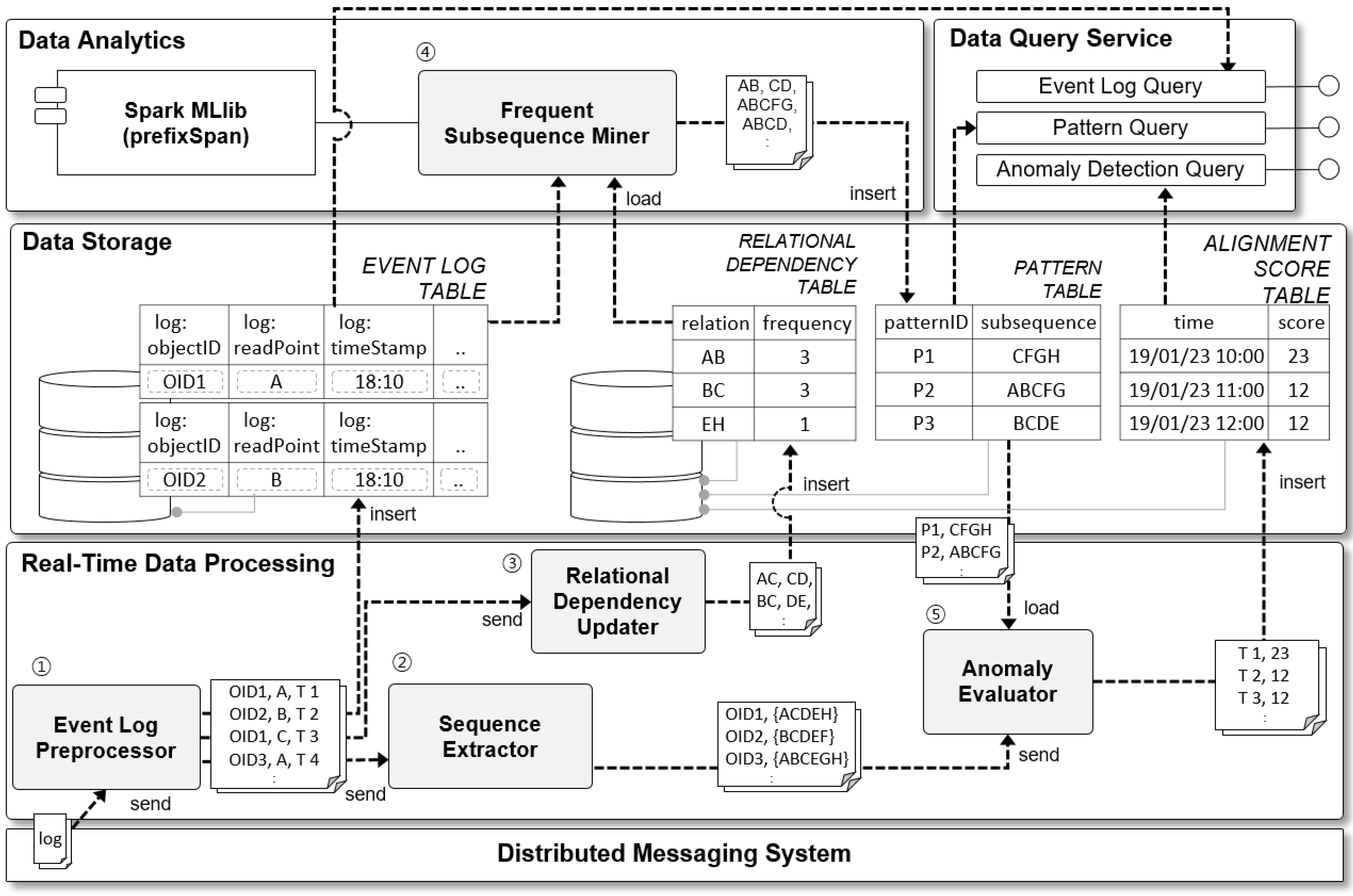
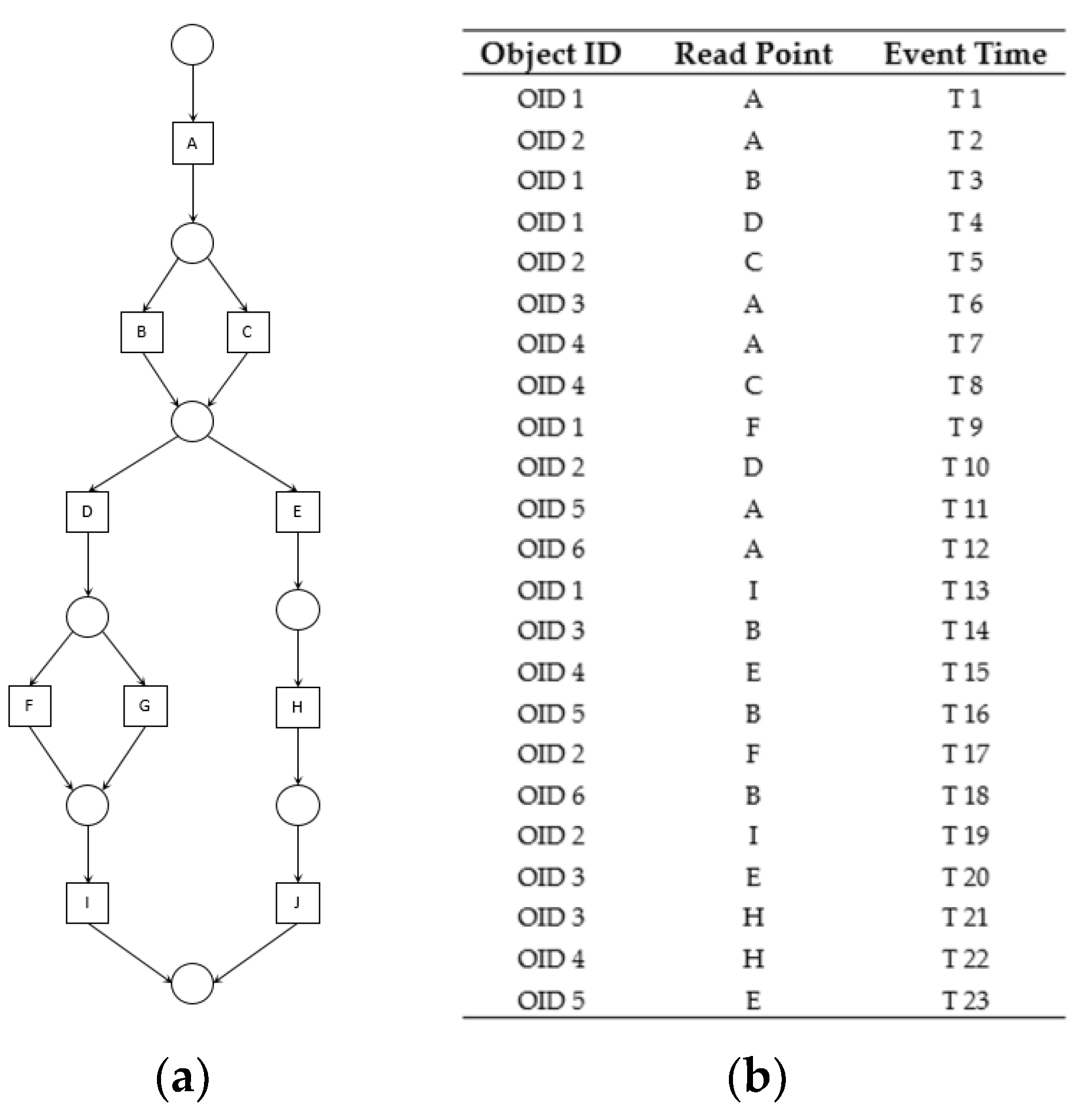


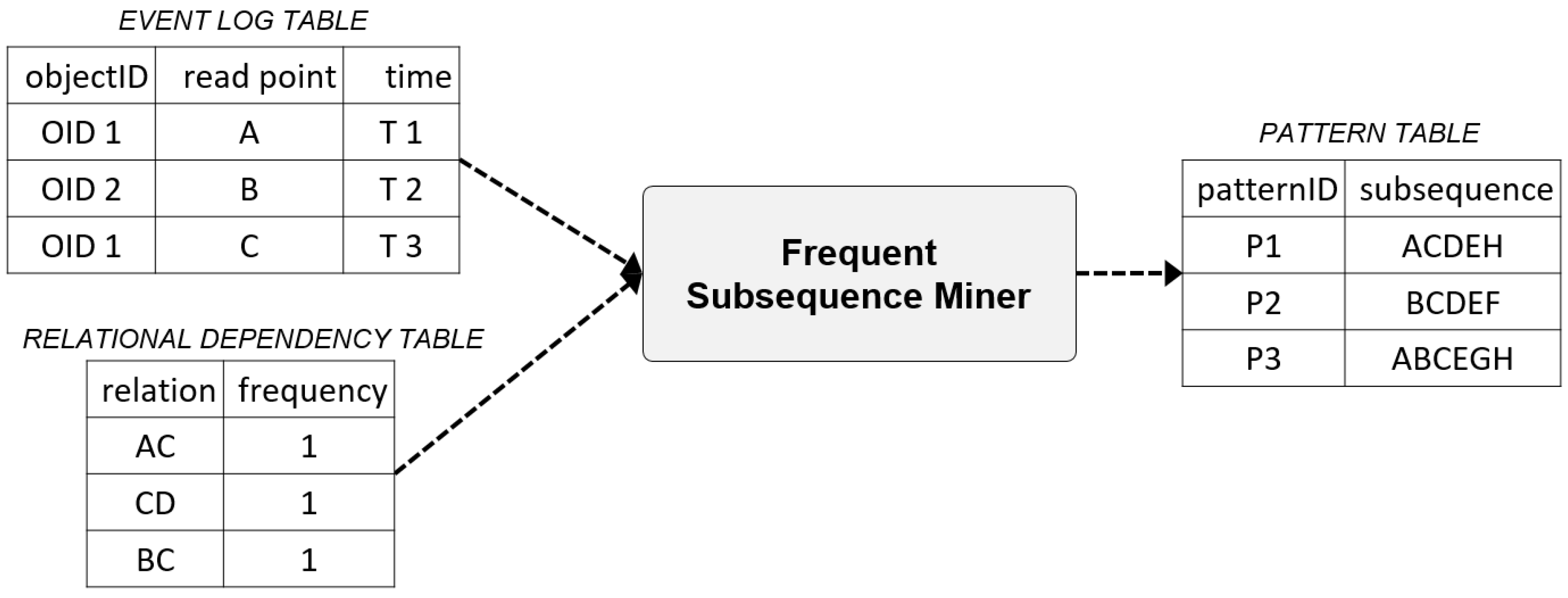
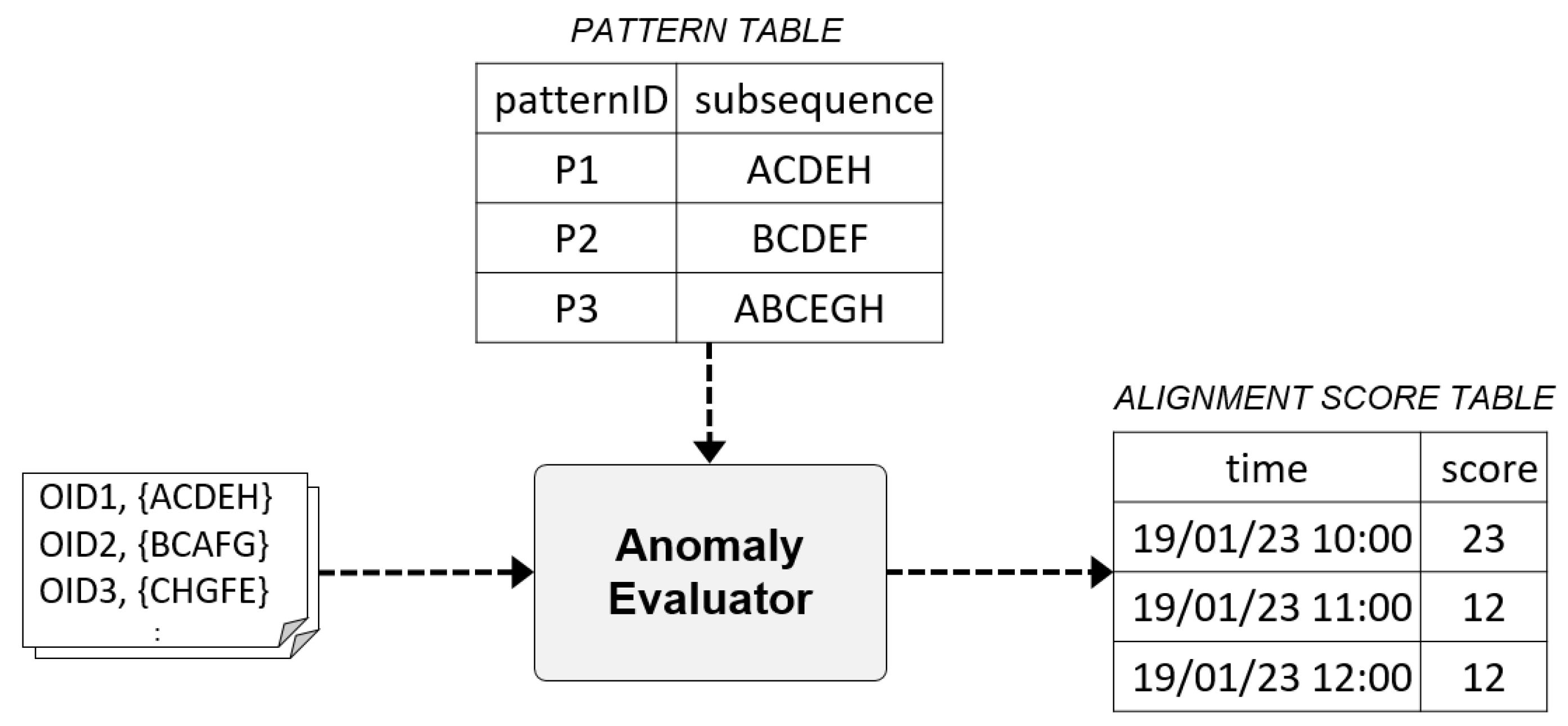

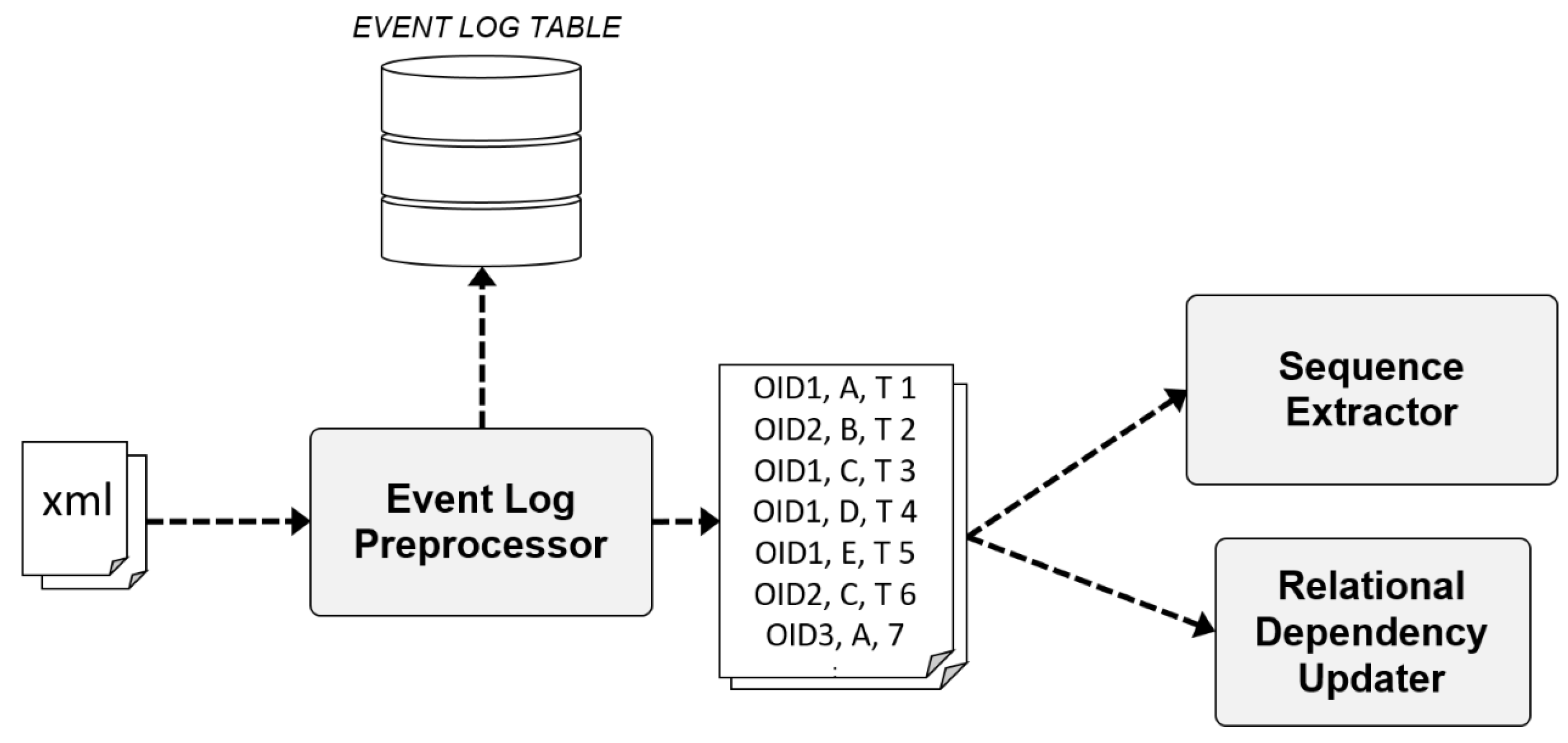


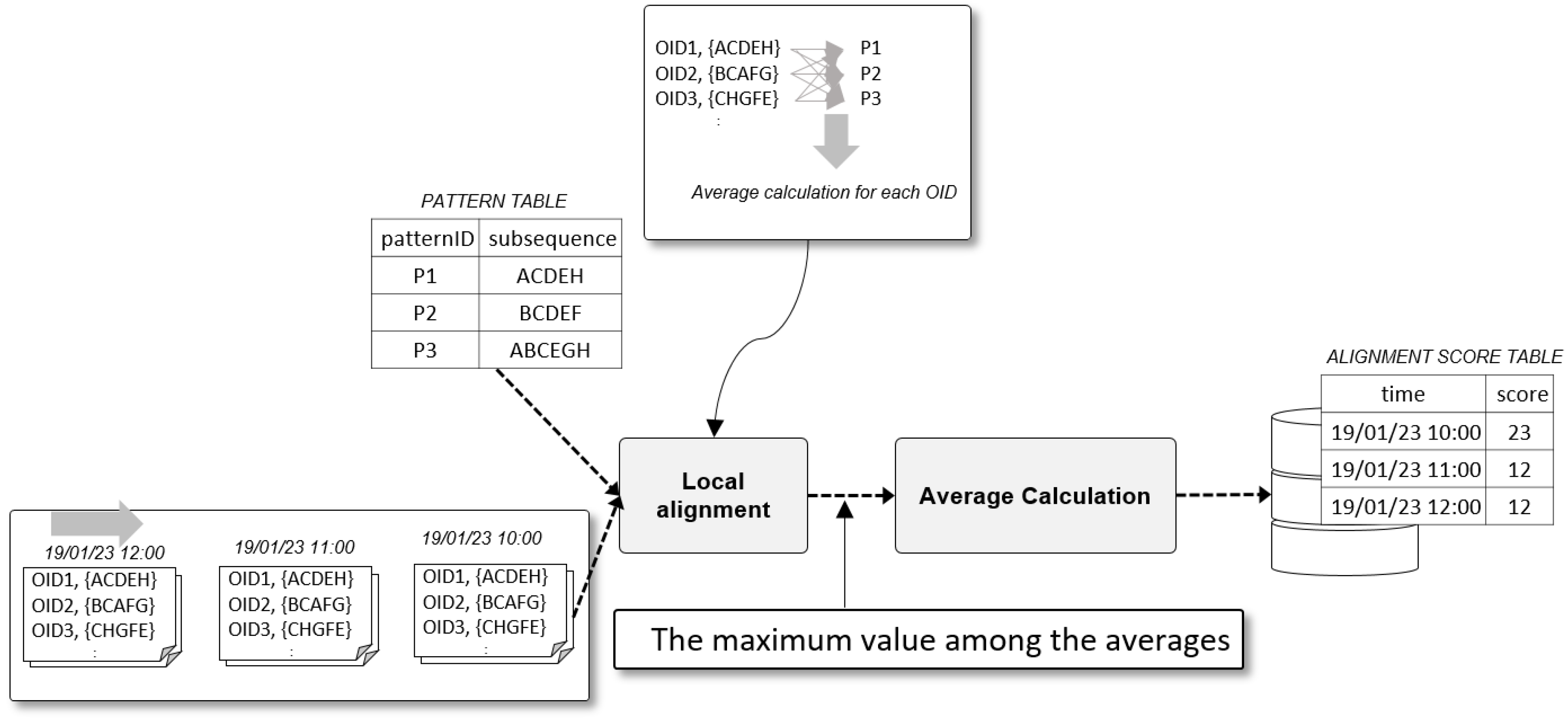
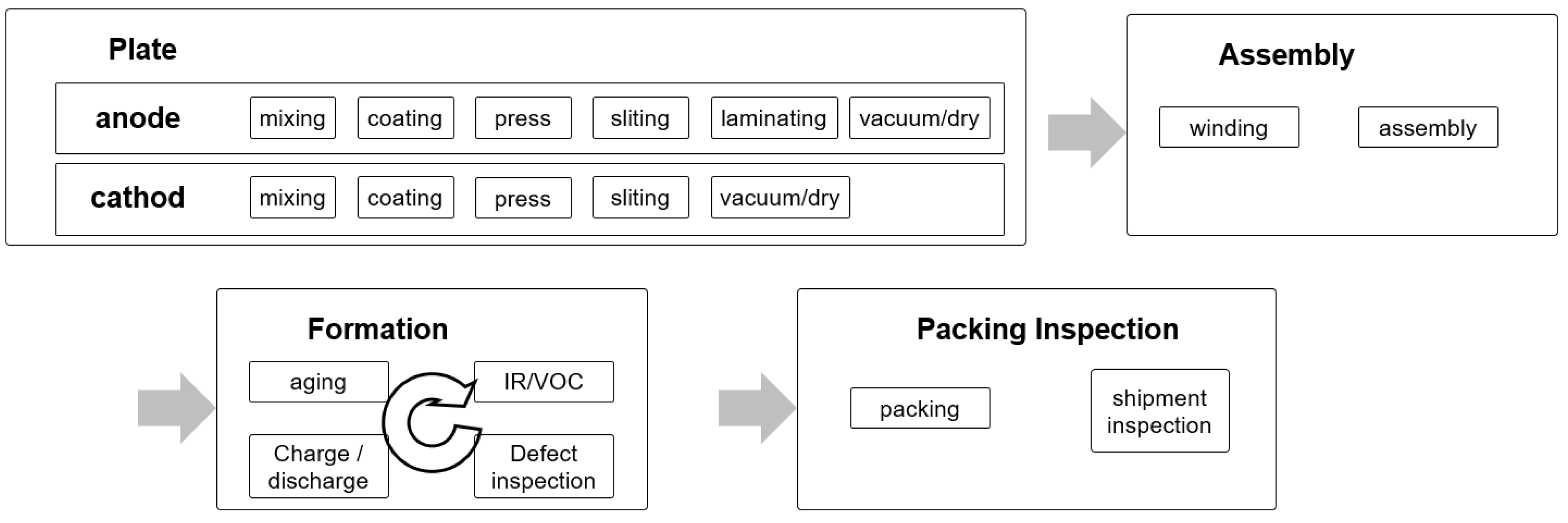
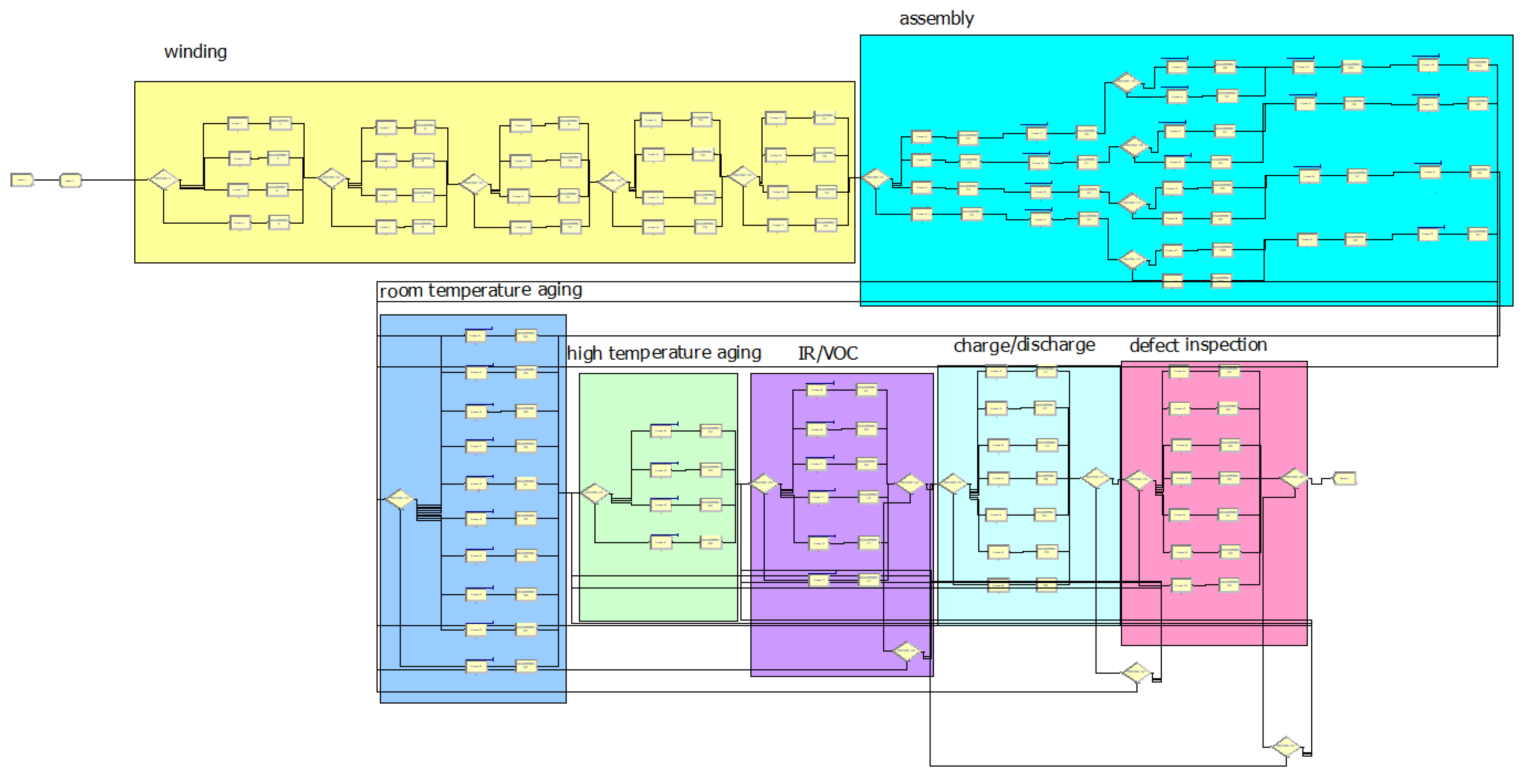

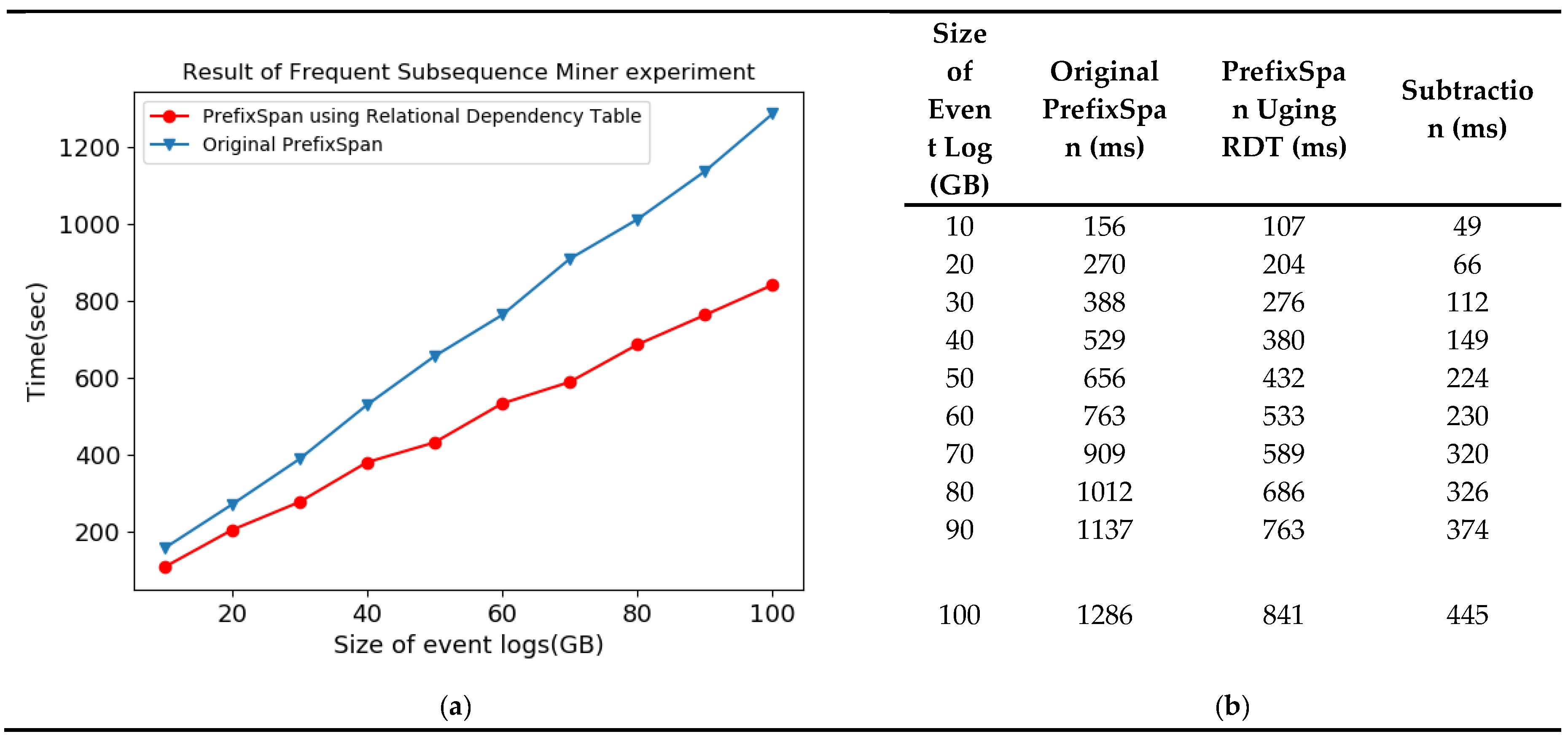
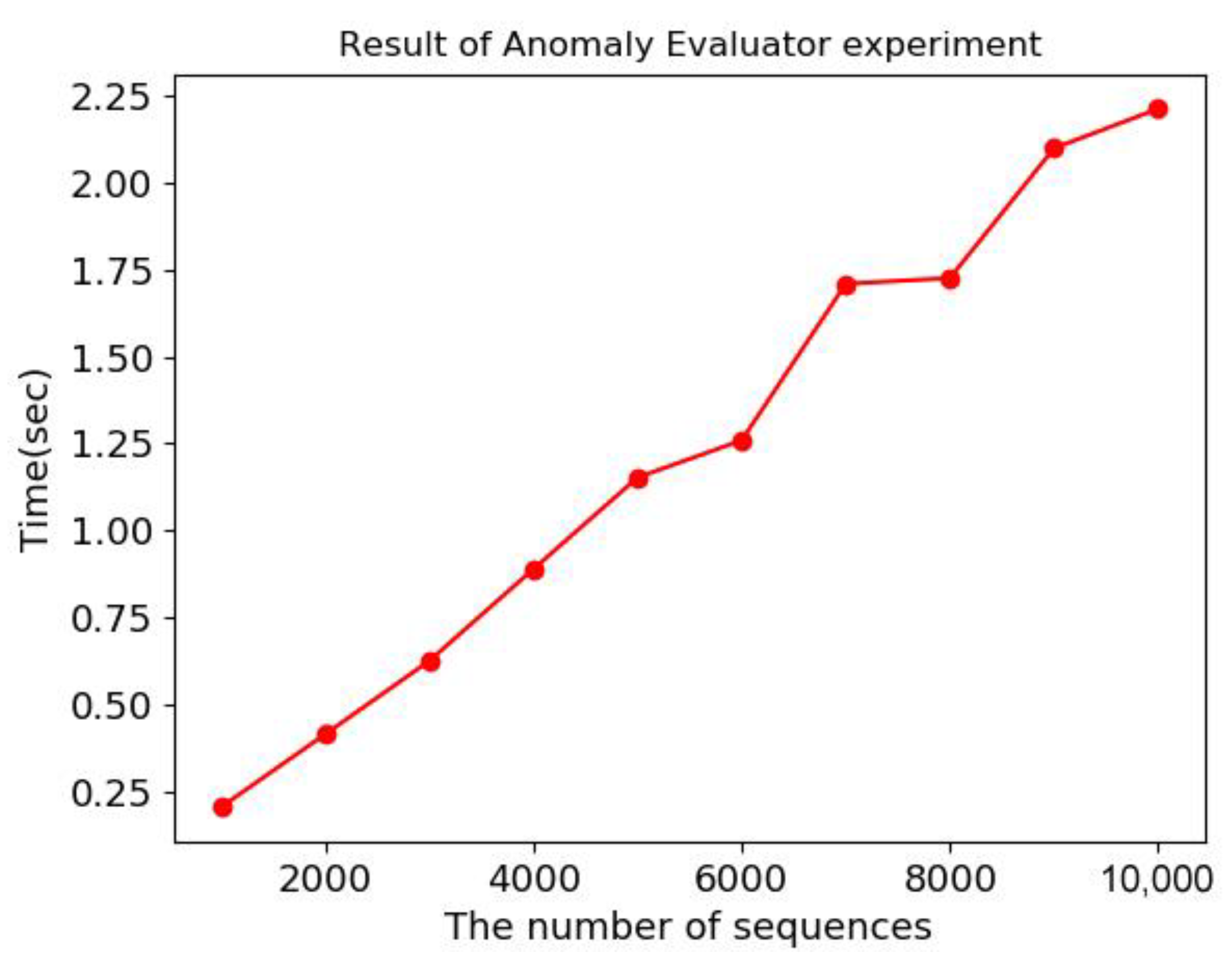
| Server Type | CPU | RAM | HDD | OS |
|---|---|---|---|---|
| Configuration Server | 3.6 GHz × 8 | 64 GB | 512 GB | Ubuntu 16.04 |
| Data Node Server | 2.2 GHz × 8 | 64 GB | 512 GB | Ubuntu 16.04 |
| Pattern ID | Pattern | Length |
|---|---|---|
| P1 | A1A5A9A13A17B1B5B9B17B21C1D1E1F1G1 | 15 |
| P2 | A3A5A10A14A19B4B8B16B20B24C1D4E4G4 | 14 |
| P3 | A4A7A10A14A20B3B7B13B19B23C8D3E4G5 | 13 |
| P4 | A1A7A9A16B2B6B11B18D2E4F3G4 | 12 |
| P5 | A1A18B3B7B19B23C9D2E5F6G6 | 11 |
| P6 | A3A10A18B2B18B22C10D1E4G3 | 10 |
| P7 | A10A14A18B16B20B24C5E2F7 | 9 |
| P8 | A3A6A19B14B19C2D2F5 | 8 |
| P9 | A3A8A15B4B8B15E1 | 7 |
| P10 | A6A9B6D1F7G4 | 6 |
| P11 | A1A13B9B17C3 | 5 |
© 2019 by the authors. Licensee MDPI, Basel, Switzerland. This article is an open access article distributed under the terms and conditions of the Creative Commons Attribution (CC BY) license (http://creativecommons.org/licenses/by/4.0/).
Share and Cite
Choi, S.; Youm, S.; Kang, Y.-S. Development of Scalable On-Line Anomaly Detection System for Autonomous and Adaptive Manufacturing Processes. Appl. Sci. 2019, 9, 4502. https://doi.org/10.3390/app9214502
Choi S, Youm S, Kang Y-S. Development of Scalable On-Line Anomaly Detection System for Autonomous and Adaptive Manufacturing Processes. Applied Sciences. 2019; 9(21):4502. https://doi.org/10.3390/app9214502
Chicago/Turabian StyleChoi, Seunghyun, Sekyoung Youm, and Yong-Shin Kang. 2019. "Development of Scalable On-Line Anomaly Detection System for Autonomous and Adaptive Manufacturing Processes" Applied Sciences 9, no. 21: 4502. https://doi.org/10.3390/app9214502
APA StyleChoi, S., Youm, S., & Kang, Y.-S. (2019). Development of Scalable On-Line Anomaly Detection System for Autonomous and Adaptive Manufacturing Processes. Applied Sciences, 9(21), 4502. https://doi.org/10.3390/app9214502






